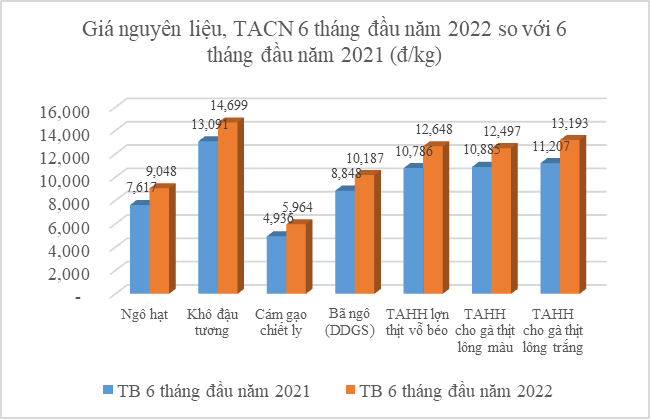Reason for price escalation of raw materials for animal feed in the first half of the year
Due to the escalation of the global price of animal feed, the price of raw materials, as well as animal feed in the first six months of 2022, increased compared to the same period in 2021.
 |
|
Source: Department of Livestock Production |
According to the latest information from the Department of Livestock Production (Ministry of Agriculture and Rural Development), from the beginning of the year to the end of June 2022, the whole country imported 8.5 million tons of animal feed materials, including aquatic products, equivalent to USD$3.7 billion (decreased by about 33.11% in quantity and 8.9% in value over the same period in 2021).
Of this corn accounted for 3.7 million tons (decreased by 52.3% in quantity and 14.71% in value); 2.2 million tons of oil dried (down 39.65% in quantity and 25.5% in value); DDGS 0.43 million tons (down 39.8% in volume and 17.3% in value); and wheat 0.73 million tons (down 3.7% in volume, up 24.26% in value).
Due to the global feed material price fluctuation, raw material prices, as well as feed prices in the first six months of 2022 both, increased compared to the same period in 2021.
Mr. Tong Xuan Chinh, Deputy Director of the Department of Livestock Production, said that the domestic price increase resulted from the new global setting in agricultural product prices (including the higher price of rice and export agricultural products of Vietnam).
In addition, the Covid-19 pandemic disrupted the global supply chain, including the supply chain of imported feed materials (supply decrease means of transportation shortage). Some large investment funds in the world switched to trading agricultural products, hoarding goods, and pushing up agricultural product prices.
“The United States, one of the major corn producing countries, increased the production of bioethanol (Ethanol) from corn, reducing the amount of exported corn. In particular, the increase in gasoline prices in February 2022 also pushed up corn prices," said Mr. Tong Xuan Chinh.
The leader of the Department of Livestock Production also further analyzed that some large corn and soybean producing countries in South America (Argentina, Brazil) have reduced maize and soybean production due to drought.
According to the US Department of Agriculture, corn production in Argentina in the 2021/2022 season is expected to fall to less than 48 million tons (previous calculation is 54 million tons), Brazil is less than 110 million tons (previous calculation is 114 million tons)
Notably, the political crisis between Russia and Ukraine (the world's largest and fourth largest wheat exporter) is negatively impacting on global food supply and prices, directly affecting corn prices and other agricultural products on the world and Vietnamese markets.
Starting from the end of May, 2022, the price of feed materials followed a slight downward trend. Currently, prices of some key raw materials have decreased compared to the average in June 2022.
Specifically: the price of corn kernels 8,600 VND/kg (down 5.5%); soybean meal 14,050 VND/kg (down 0.4%); DDGS 10,500 VND/kg (equivalent); and extracted rice bran 5,550 VND/kg (down 0.3%).
“It is forecasted that in the coming time, the prices of some key materials may be lower but not much. Recently, some countries are implementing a domestic food security policy that bans exports, which also affects the prices of corn, soybean meal, and wheat for animal feed," said Mr. Chinh.
Assessing the livestock production situation in the second half of the year, the leader of the Department of Livestock Production noted the pandemic still occurs in some localities and are under the risk of outbreaks while production costs, intermediaries, and domestic livestock product prices are still high.
In addition, in the process of market globalization and the implementation of the Comprehensive and Progressive Agreement for Trans-Pacific Partnership (CPTTP) and the Vietnam-EU FTA (EVFTA), Vietnam must compete with higher prioritized rivals who inherit large breeding areas, which can put the pressure on domestic livestock products.
Livestock products will face more and more tough competition in price, quality and product diversity when US and European livestock products, such as chicken and pork, are exported to Vietnam market.
Regarding the recent skyrocketing feed prices, Deputy Minister of Agriculture and Rural Development Phung Duc Tien requested the Department of Livestock Production to coordinate with other units in the Ministry as well as international partners to come up with proactive solutions to the source of feed. At the same time, it is necessary to pay attention to the management and quality control of animal feeds in the market.
"It is necessary to strengthen international cooperation in the livestock industry, and accelerate cooperation projects and programs with foreign partners to attract more important resources," said Mr. Phung Duc Tien.
| “As set in the whole industry target, the average growth of livestock production value in 2022 will reach about 5.0-5.5%, compared to 2021. Meat output of all kinds will reach about 6.95 million tons, up 4% compared to 2021 (in which live pork production is over 4.2 million tons and poultry meat production is over 1.9 million tons); fresh milk 1.24 million tons, up 7.3%; eggs 18.4 billion, an increase of 5%”. |








